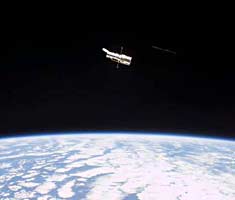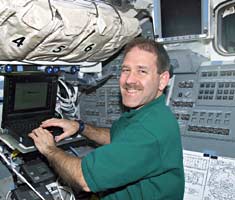
Following five days of repairs and upgrades by visiting shuttle astronauts, the Hubble Space Telescope returns to free flight on March 9th.
Courtesy NASA.
After deployment of the Hubble Space Telescope it was time to watch the Hubble slowly drift off and away from the space shuttle and to admire its beauty. The look of the telescope has been forever changed. Stout and strong-looking panels have replaced the bird-like solar array wings. The new solar arrays have deep blue gallium arsenide solar cells, replacing the silicon cells. On the other side of the arrays are white reflective panels, and so the telescope will no longer emit the golden glow so characteristic of the first 12 years of Hubble's life on orbit.
On the aft bulkhead of Hubble is a conduit leading to a large white radiator mounted to handrails on the side of the telescope. Along handrails all around the telescope are hung new cable harnesses to transfer power and signals to new systems on the telescope.
As HST moved off into the distance I could only watch in awe (and take an enormous number of photographs). What an amazing telescope that we had worked on over the previous 5 days. More remarkable is the team that developed the new instruments. The Advanced Camera for Surveys will provide us such remarkable views from its three cameras that I can't even imagine the scope of the new discoveries that it will make.
Finally, as HST became another star in the sky, we went back to work stowing the space suits and space-walking tools. The act of making Columbia a space ship again is a tough one, after spending five days using her middeck as a space-walking staging area.

Astronaut John Grunsfeld, payload commander for the fourth Hubble Space Telescope servicing mission, works on a laptop computer on Columbia's aft flight deck after completing a 7-hour space walk.
Courtesy NASA.
Fortunately, without a payload in the bay of Columbia we could also take time to look out the window at the beautiful blue Earth. I watched out the window as we passed over Hawaii searching for the domes of the Kecks, UKIRT, and the other telescopes atop Mauna Kea, with no luck. As we passed over the Andes I desperately searched for Cerro Tololo, but again to no avail. My tool for these searches is a pair of Zeiss 20 x 60 stabilized binoculars.
While my search for observatory domes was not very successful, the good news is that as we orbit the Earth we see a night and day every 95 minutes with about 35 minutes of darkness. What a joy it is to be able to darken the cabin and with naked eyes see the broad expanse of the Milky Way. From our vantage above the atmosphere the stars are steady and don't twinkle. They seem just a bit brighter, and the colors of the stars are more vibrant.
As we pass southward the Large Magellenic Cloud is easy to discern. Using the binoculars Jupiter is clearly resolved with light banding. The Great Nebula in Orion is a favorite target, as well as the many open star clusters. The crescent Moon is visible as part of a complete orb, illuminated by the bright Earth, just around the horizon. The biggest problem with trying to find faint objects is that we are moving so fast around the Earth. As a result we only have a few minutes to find an object before it sets or goes out of the view of a window.
As the stars head down towards what looks like the visible horizon at night, they first go through the airglow layer, starting at about 95 kilometers. This greenish layer results from excited atoms releasing energy in the form of light. During the day the atmosphere is constantly absorbing sunlight, and only in the night pass can we see the dull glow from the atomic deexcitation. When a bright object sets it looks like it should disappear behind the Earth, but instead we see the stars a bit longer as they go through the fog of the Earth's atmosphere. In this thin region the stars do twinkle and fade before finally blinking out as they go behind the Earth.
Tomorrow we start turning the space shuttle into a reentry vehicle. I hope that before we head back home I have more chances to look out the window and stargaze. There will be a time, and soon I believe, that many people will be able to view the stars as we have on this mission. I would not be surprised to see an observatory on the Moon sometime in this century. After all, it has always been the adventurous astronomers who brave cold nights, high-altitude environments, and even the rigors of space flight to get a better view and understanding of our universe. I am convinced that as we push out of low Earth orbit, and on to the Moon and beyond, astronomers will be there.
Whether in our own backyards, on a cold and remote mountaintop, or in Earth orbit, the beauty of the heavens is always present, and the drive to explore and to indulge our curiosity is always strong.
 0
0
Comments
You must be logged in to post a comment.